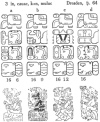
Sacred Texts Native American Maya Index Previous Next
Buy this Book at Amazon.com

Yucatan Before and After the Conquest, by Diego de Landa, tr. William Gates, [1937], at sacred-texts.com
On the departure of Cuculcán the chiefs agreed that for the permanence of the state the house of the Cocoms should exercise the chief authority, it being the oldest and richest, or perhaps because its head was at that time a man of greater power. This done, they ordained that within the enclosure there should only be temples and residences of the chiefs, and of the High Priest; that they should build outside the walls dwellings where each of them might keep some serving people, and whither the people from the villages might come whenever they had business at the city. In these houses each one placed his mayordomo, who bore as his sign of authority a short thick baton, and who was called the Caluac. This officer held supervision over the villages and those in charge of them, to whom he sent advices as to the things needed in the chief's establishment, as birds, maize, honey, salt, fish, game, clothing and other things. The Caluac always attended in the chief's house, seeing what was needed and providing it promptly, his house standing as the office of his chief.
It was the custom to hunt out the crippled and the blind in the villages, and give them their necessities. The chiefs appointed the governors and, if worthy, confirmed their offices to their sons. They enjoined upon them good treatment of the common people, the peace of the community, and that all should be diligent in their own support and that of the lords.
Upon all the lords rested the duty of honoring, visiting and entertaining Cocom, accompanying and making festivals for him, and of repairing to him in difficult affairs. They lived in peace with each other, and with much diversion according to their custom, in the way of dances, feasts and hunting.
The people of Yucatan were as attentive to matters of religion as of government, and had a High Priest whom they called Ahkin May, or also Ahaucan May, meaning the Priest May, or the High Priest May. He was held in great reverence by the chiefs, and had no allotment of Indians for himself, the chiefs making presents to him in addition to the offerings, and all the local priests sending him contributions. He was succeeded in office by his sons or nearest kin. In him lay the key to their sciences, to which they most devoted themselves, giving counsel to the chiefs and answering their inquiries. With the matter of sacrifices he rarely took part, except on it festivals or business of much moment. He and his disciples appointed priests for the towns, examining them in their sciences and ceremonies; put in their charge the affairs of their office, and the setting of a good
example to the people; he provided their books and sent them forth. They in turn attended to the service of the temples, teaching their sciences and writing books upon them.
They taught the sons of the other priests, and the second sons of the chiefs, who were brought to them very young for this purpose, if they found them inclined toward this office.
The sciences which they taught were the reckoning of the years, months and days, the festivals and ceremonies, the administration of their sacraments, the omens of the days, their methods of divination and prophecies, events, remedies for sicknesses, antiquities, and the art of reading and writing by their letters and the characters wherewith they wrote, and by pictures that illustrated the writings.
 Click to enlarge |
They wrote their books on a long sheet doubled in folds, which was then enclosed between two boards finely ornamented; the writing was on one side and the other, according to the folds. The paper they made from the roots of a tree, and gave it a white finish excellent for writing upon. Some of the principal lords were learned in these sciences, from interest, and for the greater esteem they enjoyed thereby; yet they did not make use of them in public. *
13:* The text figure shows the general arrangement of the texts in both the Dresden and Madrid codices; that in the Paris codex and on the monuments was quite different.
Here, in section, or tzolkin 64 of the Dresden, we see the figure of Itzamná in four different activities, in each accompanied by one of the four major food animals, the turkey, iguana, fish and deer. Above each are four glyphs, the first identical save for the subfix element in the fourth column; this may be taken as en introductory to an invocation, or chanting rhythm, such as actually found in one of our most important Maya manuscripts, the Ritual of the Bacabs. The four glyphs across in the second Line represent the North, West, South and East. In the next position we see the head as of a 'lord,' wearing a ceremonial banded headdress, preceded by the known signs for the four colors attached to the four Directions: White, Black, Yellow, Red. In the bottom row the repeated glyph of Itzamná, accepted as such from its constant occurrence above his figure as shown here.
Finally, since the composition of the original codex of which the existing 'Dresden codex' is rather clearly a copy, is to be placed from its own internal evidence as relating to the moon and eclipse calculations finally worked out probably at Copan, about the year 750 A. D., the uncertainties involved in any effort to read this in the modern forms of Yucatecan Maya (or other), are just about as great as should one ignorant of historical English try to treat the text of Beowulf as if it showed the spoken English of today.